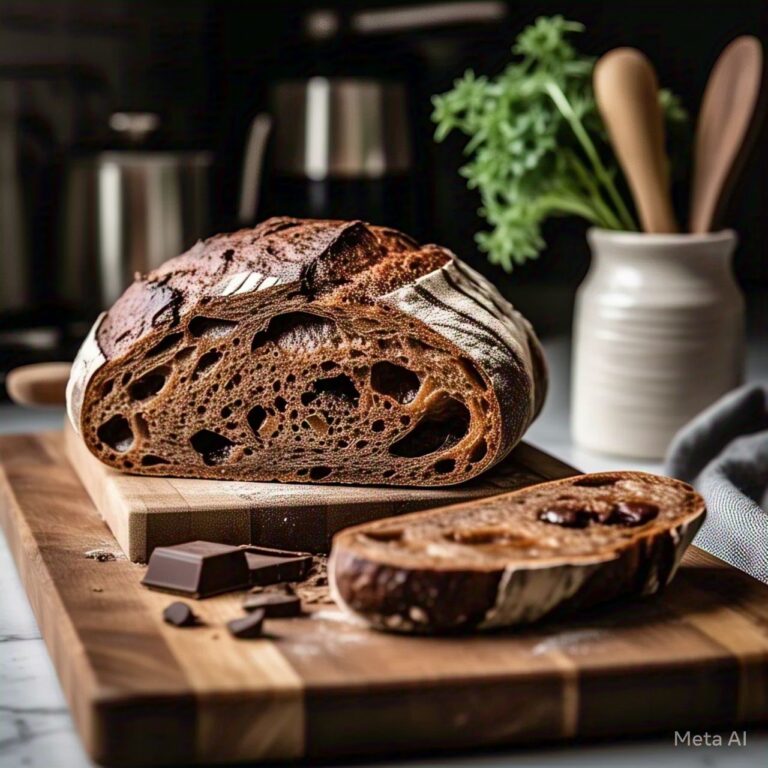Overproofed Sourdough
Sourdough bread, with its distinct tangy flavor and chewy texture, has been a staple in many kitchens for centuries. However, as any seasoned baker knows, making sourdough is an art, and every element needs to be in harmony from the flour and water to the fermentation process. One common issue that can throw off this delicate balance is overproofing.
In this blog, we’ll dive deep into the topic of overproofed sourdough what it is, how it happens, and how to deal with it.
What is Overproofed Sourdough?
Overproofing occurs when the dough ferments for too long, causing it to rise beyond its optimal point. During the fermentation process, yeast and bacteria consume sugars in the dough, producing gases (carbon dioxide) that cause the dough to rise. When dough is overproofed, it’s often a sign that the yeast has exhausted all its available sugars, and the dough has become too airy, too weak, and too delicate.
A telltale sign of overproofing is that the dough loses its structure, resulting in a flat loaf, deflated crumb, and poor oven spring. When baked, overproofed sourdough often has an open, irregular crumb structure and may collapse upon cooling.
Causes of Overproofing
Several factors can lead to overproofing sourdough. Understanding them can help you avoid this issue in the future.
1. Too Long of a Fermentation Time
One of the most common reasons for overproofing is simply allowing the dough to ferment for too long. Every sourdough starter has its own unique characteristics, which can affect the fermentation time. While some starters may rise within a few hours, others may require longer periods. The dough can be overproofed if left for too long during bulk fermentation or proofing (the second rise).
2. High Temperature
Temperature plays a crucial role in fermentation. Yeast activity speeds up in warmer temperatures, so if the dough is kept in a warm environment (over 80°F or 27°C), the yeast will be much more active, causing the dough to rise too quickly. On the other hand, too cold an environment can lead to slow fermentation, which may result in underproofing instead.
3. Incorrect Hydration
The hydration level of your dough (the ratio of water to flour) can also contribute to overproofing. High hydration doughs are more delicate and require more attention. The extra moisture allows yeast to work faster and can make the dough more prone to overproofing if left unchecked.
4. Too Much Starter
Using too much sourdough starter (or levain) relative to the flour in the dough can speed up fermentation. If you’re working with a particularly strong or active starter, it may cause the dough to rise too quickly.
5. Inadequate Shaping
Shaping your dough correctly during the bulk fermentation phase is essential for creating a strong structure that holds up during proofing and baking. If the dough is poorly shaped or lacks tension, it may not rise properly and may collapse in the oven. Poor shaping can sometimes result in an overproofed, weak loaf.
6. Misjudging the Final Proof
Final proofing is the last rise before baking. If you let the dough proof too long after shaping, it can lead to overproofing. It’s essential to check for signs of readiness, such as the “poke test” (when you gently press your finger into the dough, it should slowly spring back but leave a slight indentation).
Signs of Overproofed Sourdough
Overproofed dough exhibits certain characteristics that can be easily identified. These signs include:
1. Overly Soft, Gassy Texture
Overproofed dough tends to feel soft and fragile, almost like it’s deflating. The structure has weakened due to excessive fermentation, and it may not bounce back when poked or pressed.
2. Excessive Spread
If the dough has spread too much and has lost its round shape, it’s a sign that it’s overproofed. The dough may become flat and wide, and when baked, it may lack the expected lift and oven spring.
3. Cracked or Ripped Crust
When sourdough is overproofed, the dough’s surface often cracks or rips during baking. The crust can become uneven, and the loaf may look unevenly risen, as the weak structure fails to support the gas build-up.
4. Smaller Oven Spring
Oven spring is the dramatic rise that occurs during the initial moments of baking, caused by the steam inside the dough. Overproofed dough often has little to no oven spring. Instead of rising quickly and dramatically, the dough may collapse and remain flat.
5. A Flat, Dense Crumb
A well-proofed sourdough has an airy, open crumb with irregular holes, the hallmark of good fermentation. Overproofed dough will have a dense and gummy crumb with large, irregular holes, often resembling a pancake texture.
Effects of Overproofed Sourdough
Overproofed sourdough may look disappointing and lack the ideal rise, but it’s still edible. However, the texture and flavor can be negatively affected:
1. Dense and Gummy Texture
Overproofing weakens the dough’s gluten network, making it difficult for the dough to hold its structure when baked. This results in a dense, chewy, and sometimes gummy texture in the crumb.
2. Loss of Flavor
Overproofing can cause the dough to become overly sour. While a slight tang is characteristic of sourdough, overfermentation leads to excessive acidity, which can overpower the delicate balance of flavors.
3. Reduced Oven Spring
The dough’s failure to rise properly in the oven results in less oven spring. This diminishes the visual appeal of the bread and may leave it looking flat or misshapen.
4. Structural Collapse
When overproofed dough is baked, it often has a weak structure that can’t support itself. As a result, the bread may collapse in the oven or become misshapen during cooling.
Solutions for Overproofed Sourdough
While overproofed sourdough may not result in the perfect loaf you were hoping for, there are a few ways to mitigate or salvage the dough.
1. Refrigeration to Slow Down Fermentation
If you suspect your dough is overproofing, you can slow down fermentation by placing it in the refrigerator for several hours (or overnight). Cold fermentation helps to preserve the dough’s structure and slow down the yeast’s activity, allowing the dough to regain some strength.
2. Bake Immediately
If the dough is only slightly overproofed and shows signs of collapse but hasn’t fully lost its structure, bake it immediately. The heat of the oven can help set the dough’s structure before it completely falls apart.
3. Gentle Shaping and Handling
If the dough has overproofed but is still workable, handle it gently during shaping. Avoid deflating it too much, as this could further disrupt the gluten structure.
4. Increase Hydration or Starter Ratio
If you are consistently facing overproofing, consider adjusting the hydration level or the amount of starter used. A lower hydration dough or a more moderate starter amount can slow down fermentation.
5. Better Temperature Control
Invest in a thermometer or control the ambient temperature in your proofing environment. A consistent temperature of around 70°F (21°C) is ideal for sourdough fermentation. Be cautious of high temperatures that can cause your dough to ferment too quickly.
6. Observe the Dough, Not the Clock
Rather than relying on strict times for proofing, observe the dough’s behavior. Look for signs like dough expansion, the “poke test,” or when the dough starts to hold its shape more loosely to determine when it’s ready to bake.
Preventing Overproofing in the Future
To prevent overproofing in the future, here are a few general tips:
- Learn Your Starter’s Behavior: Every sourdough starter is different, and the fermentation time can vary significantly. Spend time understanding how your starter behaves, its rising times, and temperature preferences.
- Use the “Poke Test”: This simple test is a great way to check if your dough is overproofed or ready for baking. Lightly poke the dough with your finger, and if the dough slowly springs back but leaves a slight indentation, it’s ready to go. If it springs back quickly, it needs more time; if it doesn’t spring back at all, it’s overproofed.
- Don’t Rush Proofing: Give your dough ample time to develop flavor and structure. Rushing the proofing process often leads to issues like overproofing, so be patient and let the dough rise at its own pace.
- Adjust for Temperature and Humidity: Both temperature and humidity can affect how quickly dough rises. Be mindful of environmental changes, particularly during different seasons or weather patterns.
- Consider Bulk Fermentation Duration: Some bakers prefer extended bulk fermentation to improve flavor. Just make sure not to let the dough go past the point where it’s overproofed.
Conclusion
Overproofed sourdough is an issue many bakers encounter at some point in their sourdough journey, but it’s not the end of the world. By understanding the causes, recognizing the signs, and applying the proper techniques, you can avoid overproofing or salvage it when it happens. Sourdough baking is a learning process, and every loaf, even the overproofed ones, is a valuable lesson in perfecting your craft.
If you want to explore whole site CLICK HERE.
FAQS
What is overproofed sourdough?
Overproofed sourdough happens when dough ferments too long. This makes the bread dense and flat.
What causes overproofing in sourdough?
Overproofing can come from wrong temperatures, overmixing, or too long rest times.
How does temperature affect sourdough fermentation?
Temperature is key in sourdough fermentation. Yeast needs the right temperature to work well. Wrong temperatures can mess up the fermentation.
What are the common causes of overproofed sourdough?
Overproofed sourdough often comes from dough that’s too wet or dry. Also, proofing at the wrong temperature or for too long can cause it.
How can I identify the perfect proof point for my sourdough?
Finding the perfect proof point takes patience and practice. It’s about knowing the dough and the proofing environment well.
What techniques can I use to control the temperature for perfect sourdough proofing?
There are many ways to control temperature. You can use a cooler spot, a warmer spot, or even special proofing boxes.







